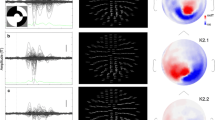Summary
Human averaged visual evoked potentials (VEPs) have been recorded to the onset, reversal and offset of motion of a visual noise pattern as in the previous paper; and to the appearance and disappearance of stationary and of moving noise patterns. These VEPs have been compared.
The VEPs to motion-reversal and -offset and pattern-appearance were very similar in waveform and scalp-distribution, and in inter-subject variation; and all three components of each of these VEPs reversed polarity between upper and lower half-field stimulation.
Motion-onset and pattern-disappearance VEPs were similar to each other but very different from the former group of VEPs; and they did not clearly exhibit polarity reversal between the upper and lower half-fields.
The pattern-appearance and -disappearance VEPs were largest for stationary patterns, and all components were steadily reduced as the stimulus velocity was increased.
Previous research implies that the motion-reversal VEPs are genuine responses to changes in the motion as such. From the data presented in this and the previous paper it is concluded that the motion-offset and -onset VEPs likewise may be largely the product of motion-sensitive mechanisms when the stimulus velocity is less than about 10dg/sec.
Similar content being viewed by others
References
Brindley, G.S.: The variability of the human striate cortex. J. Physiol. (Lond.) 225, 1–3P (1972).
Clarke, P.G.H.: Visual evoked potentials to sudden reversal of the motion of a pattern. Brain Res. 36, 453–458 (1972a).
Visual motion-evoked potentials in man. Unpublished. Keele: Ph. D. Thesis 1972b.
— Visual evoked potentials to changes in the motion of a patterned field. Exp. Brain Res. 18, 145–155 (1973).
Halliday, A.M., Michael, W.F.: Changes in pattern-evoked responses in man associated with the vertical and horizontal meridians of the visual field. J. Physiol. (Lond.) 208, 499–513 (1970).
Jeffreys, D.A.: Cited in MacKay, D.M. (Ed.). Evoked brain potentials as indicators of sensory information processing. Neurosciences Res. Prog. Bull. 7, 214–215 (1969).
—, Axford, J.G.: Source locations of pattern-specific components of human visual evoked potentials. I. Component of striate origin. Exp. Brain. Res. 16, 1–21 (1972a).
—, Axford, J.G. Source locations of pattern-specific components of human visual evoked potentials. II. Component of extra-striate origin. Exp. Brain Res. 16, 22–40 (1972b).
MacKay, D.M., Rietveld, W.J.: Electroencephalogram potentials evoked by accelerated visual motion. Nature (Lond.) 217, 677–678 (1968).
Marshall, C., Harden, C.: Use of rhythmically varying patterns for photic stimulation. Electroenceph. clin. Neurophysiol. 4, 283–287 (1952).
Rietveld, W.J., MacKay, D.M.: Cited in MacKay, D.M. (Ed.). Evoked brain potentials as indicators of sensory information processing. Neurosciences Res. Prog. Bull. 7, 211 (1969a).
Rietveld, W.J., MacKay, D.M. Evoked responses to acceleration and to tachistoscopic presentation of patterned visual stimuli. Electroenceph. clin. Neurophysiol. 26, 537P (1969b).
Spekreijse, H., Tweel, van der L.H., Regan, D.: Interocular sustained suppression: correlations with evoked potential amplitude and distribution. Vision Res. 12, 521–526 (1972).
Vaughan, Jr., H. G.: The relationship of brain activity to scalp recordings of event-related potentials. In: Averaged Evoked Potentials. Ed. by E. Donchin, and D.B. Lindsley. Washington, NASA SP-191, 45–94 (1969).
Wurtz, R.H.: Visual receptive fields of striate cortex neurons in awake monkeys. J. Neurophysiol. 32, 727–742 (1969).
Author information
Authors and Affiliations
Rights and permissions
About this article
Cite this article
Clarke, P.G.H. Comparison of visual evoked potentials to stationary and to moving patterns. Exp Brain Res 18, 156–164 (1973). https://doi.org/10.1007/BF00234720
Received:
Issue Date:
DOI: https://doi.org/10.1007/BF00234720




